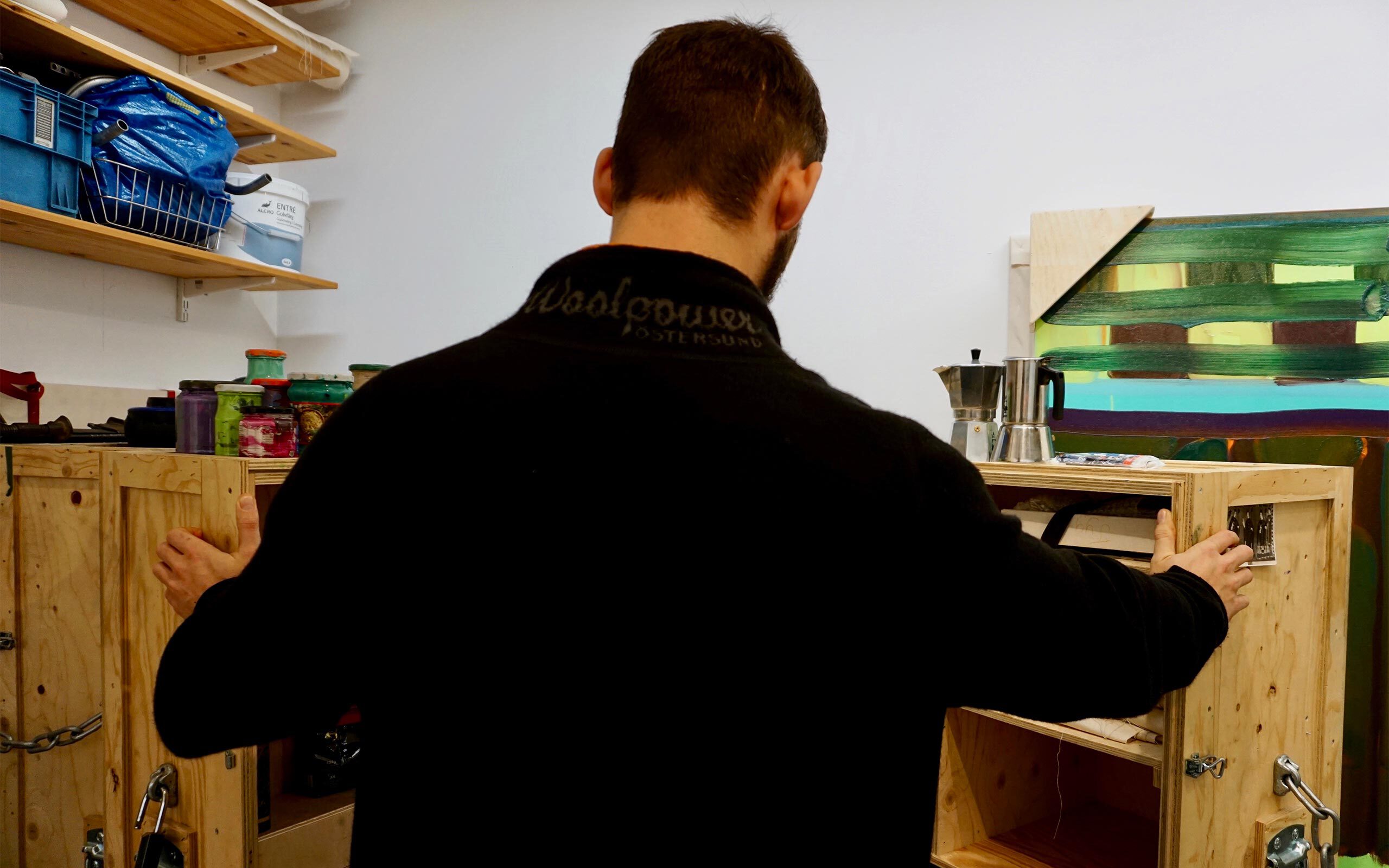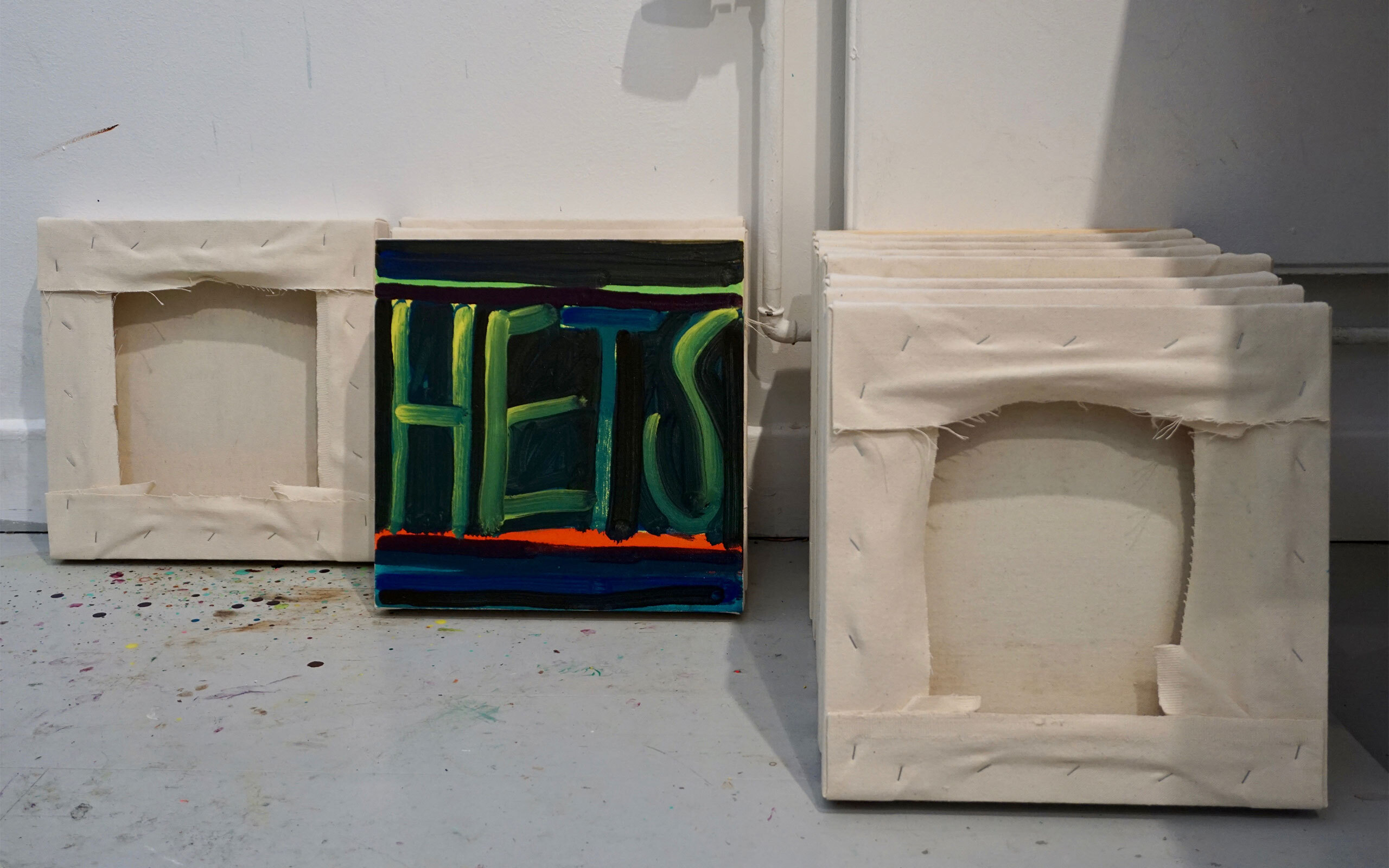The scene for contemporary art in Europe’s North is expanding and developing new dynamics as international collectors are watching the scene. With Nordic Notes we regularly cast the eye on the Nordic art and cultural scene, portraying its important actors.

Swedish painter Johannes Hägglund belongs to a fortunate few within his generation of artists who have had the good fortune to be represented by a reputable gallery while still at art school. While this was once considered taboo for a gallery, strictures have been slowly loosening in the local art scene, and by the time that Johannes Hägglund presents his MFA graduate exhibition, he will already have shown two solo exhibitions with Galerie Forsblom in both Stockholm and Helsinki. In this interview, Johannes elaborates on how decisions and choices in his practice relate to the continuous striving to evolve his craft as a painter. While neither a purely abstract nor figurative painter, the artist says he is less interested in the motif than in the associated painterly process.
Johannes, how long ago did you start making art?
As a child in the first years of school; I was in Montessori educational programs which meant we got to develop our creativity through painting and crafts-related activity. In hindsight, I realize that mirrors exactly what I’m doing today, although there were years in between where there were gaps in this sort of practice. But looking back, I think I was already being shaped by this while very young.
Do you remember what you might identify as your first substantial “artwork”?
Not exactly. I never had an idea as a child that I wanted to become an artist per se or even that I was making art for that matter. There was no contact with what you could call an art world or even the knowledge of what a gallery was. But what always existed from early on was a need to create with my hands.
Did you ever consider the possibility of an alternative profession?
There was never anything else in the picture as I remember. I think rather that I’ve both consciously and subconsciously made decisions that gradually put me onto this path, for instance by choosing an aesthetical program back at high school.

You’re currently pursuing and completing your MFA at the very prestigious Royal Institute of Art in Stockholm where we are conducting this interview. What has been your experience here?
This great allure of attending an art school like this, I think is something that exists primarily prior to getting there. I think some of the ideas and expectations one has in mind in terms of a grandeur of sorts become more realistic in due time while studying. Being here does of course open some doors and you might have eyes on you from the outside to a greater extent than elsewhere.
Your studio is so neatly organized. Everything looks so tidy and you’ve even built your own wooden storage and archival cabinets inside which look very intricate to me. I imagine it’s a great benefit to be skillful and self-sufficient this way.
I have a great wish to be independent and to do as much as possible myself and not to be reliant on others for my direct needs any more than is necessary. I enjoy making my own frames and I made some of the furniture you see in the studio. I believe this relates to my wish to facilitate the creative process and allowing it to be smooth and free from time and financial constraints at least as far as others are concerned. I really do enjoy handiwork, to me it is fun and in fact it has also proven to be a financial resource in so far as helping others with their tasks.
In your early work, plants and vegetation were both very evident and vivid motifs, where did that interest come from?
I don’t think there was a particular intention in those works to convey such an interest, it came down to my wanting to channel and reflect the energy generated by me in the process of painting. As a very structured and controlled person, I attempt to find systems and structures to guide my painting. I am neither merely a figurative nor an abstract painter, but I want something tangible from which to depart, and in that I strive to arrive at a certain realm of imagery. I was doing a lot of analogue photography a few years, and began painting lumber that I had photographed. However, I wasn’t happy with the way that my painting was restricted to straight lines rather than flowing, more organic shapes. A friend of mine had found a box of old photographic slides of images from a banana plantation in Gran Canaria; I liked the organic shapes informed by the images which allowed me to branch out and develop my painting.





Are there any common misconceptions about your work that you would like to address?
I don’t think there’s anything in particular that I’m aware of. But something that does come to mind is this thing about people often wanting to see “something” in painting. A wish for the depictive to appear with a certain immediacy, which I totally understand but which can be limiting. For me it’s actually less about what is depicted and more about the painting itself. I’m more interested in the brush strokes on the canvas and with the colors than the final motif itself.
You belong among the young emerging artists in Sweden who’ve received great exposure and visibility considerably early and are even, while still at art school, represented by a major gallery, Galerie Forsblom. What sort of pressure has this placed on you?
Because school is such an open place to grow and develop without consideration of the outside world, I may have been a little worried that all this might infringe on the freedom one anticipates enjoying at this stage, although I tend to feel that it hasn’t. It is a reality however, that exposure to and contact with the commercial art world means that considerations which ought not to be, are brought into your studio. But I do feel very relaxed for the present.
When you presented your first solo exhibition with Galerie Forsblom in Stockholm in 2018, it was evident that the direction had shifted towards visually stark compositions, a feast of colors and works that were even compared to candy. Tell us more about this departure towards something more abstract.
Everything returns to this striving to keep on learning and progressing in my painting. I often think that painting should be about joy because if it isn’t, something is missing for me. I think I got to the point where the works I was doing involving plants, while allowing me to be free, also imposed a restriction on me inasmuch as they did not leave much room for change once a work was completed. So, I started elaborating on a process in which compositional layers could be built up while continually being changed and expanded upon. I also wanted to more freely try out colors and to find a new visual realm to use as a point of departure.
Do you have a specific philosophy about colors that you could share?
Not exactly, but I would say that I experience a genuine excitement in working with colors and in finding a balance between them, even in combinations that are as strange and unusual as I can possibly make them. I sketch a lot with colored markers and in doing so I will arrive at odd combinations which I will later try to transfer to and incorporate into my painting, I sketch a lot with color markers and while doing that I will arrive at odd combinations which I later try to transfer and integrate into my painting. And when that happens a need arises to adapt and modify, so in a way it’s all an organic play with colors.


Something that does characterize your surfaces is the texture and materiality of the paint itself through the occasional heavy impasto, adding a tactile element. You can sort of detect the energy you were talking about and the swift movements. Also found in your works more recently are texts and written expressions, what does this approach signify?
It’s quite new to me still. It’s yet again about finding an element that brings a certain joy and boost in the studio; something that will lend itself to the painting by way of new shapes or directions to extract. As a result, I’ve begun to incorporate text in my painting. Nevertheless, for me, the fragments of text are not of a primary nature. This may sound paradoxical, since the words bear meaning and ascribe something concrete and direct to the painting which can be grasped immediately. I’m currently still trying to formulate for myself what significance text has in my work. I recently tried to move away from words, only to realize that I really wanted to have them.
How do you choose the words? I’m thinking about words I’ve seen before and am seeing here like; “Faster Harder”, “Teaser”, “Sports” and “Hets”. These are all intense, active and physical words.
A lot has to do with the shape of the actual words and the letters, and what possibilities they bring. Some words just come to me. This week has been a very stressful one, so I’ve found myself doing a ton of smaller paintings on which it says “Stress” or “Knas”. On another one it says “Thrasher” and with that one, I really didn’t want any text at all, but I kept painting and painting and there was such frustration about feeling that I was working against myself. In the end that one got to be “Thasher” because that’s how I felt about it in the moment.
You recently opened a solo exhibition with Galerie Forsblom in the Helsinki venue and an unlucky turn of events involving a water leak, caused the gallery to close after only a week. For such a perfectionist as you seem to be, this must have unimaginably frustrating, as indeed it would be for anyone. How did you react to this curtailment of your controlled creative environment?
I was calmer than you might think. When you work with a commercial gallery and present an exhibition, you do all this work preparing it, but once it is installed, there is a point in which you relinquish responsibility. In this kind of circumstance, there is no one to whom blame can be directed, or for anger at who may have “fucked up”. It’s just a case of the unforeseen disrupting things, a little sad, but what can you do? Ultimately, a solution can always be found.
You finished the works for your graduate MFA-exhibition at the end of 2019. What can you lastly tell us about what you were presenting?
The show was called En lång dag är över (A long day has has drawn to a close). I can say that I’ve made some works for the exhibition that do not entirely look like any works I’ve done before. They present as a reaction to the work I’ve been doing leading up to recently. I feel like my work has got to a point where it looks visually very titillating, pleasing, and meticulous. That’s been very rewarding and valuable to me in my practice and learning, but that’s not really where I want to be. So, in these works in the graduate exhibition I’ve tried to bring a lot more punkishness into them. I’ve deliberately made them grittier and “uglier”, you could say, while still developing the painterly technique and touch that is important to me.



Interview: Ashik Zaman
Photos: Maria-Corina Wahlin
Links: Johannes Hägglund's website Galerie Forsblom Helsinki






